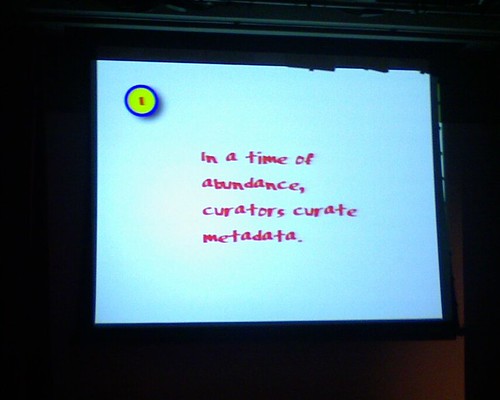Ithaka has recently released the full findings from their 2006 surveys of the behavior and attitudes of faculty members and academic librarians. The faculty study focuses on the relationship between faculty and the library, faculty perceptions and uses of electronic resources, the transition from print to electronic journals, faculty publishing preferences, e-books, digital repositories, and the preservation of scholarly journals. The librarian survey complements the faculty study, exposing the similarities and differences between faculty and librarian views of key topics.
This is an extended quotes describe two very interesting key perceptual differences:
Over the course of these three surveys, we have tested three “roles” of the library – purchaser, archive and gateway. We have attempted to track how the importance of these three different roles has changed over time. Most highly rated among these roles is that of library as purchaser – faculty don’t want to have to pay for scholarly resources, a finding which holds across disciplines and has remained stable over time. There is slightly more variation by discipline in views on the importance of the library’s preservation function, but valuation of this role is also uniformly high and has remained static over time. The importance of the role of the library as a gateway for locating information, however, varies more widely and has fallen over time.
The declining importance assigned to the gateway role is cause for concern in general, and especially when considered by discipline. The importance to faculty of this role has decreased across all disciplines since 2003, most significantly among scientists. While almost 80% of humanists rate this role as very important, barely over 50% of scientists do so. Beyond the differences between these general disciplinary groups, there also exist substantial variations by individual discipline, as demonstrated by the perceptions of economists. Between 2003 and 2006, the percentage of economists indicating they found the library’s gateway role to be very important dropped almost fifteen percentage points. In 2006, the percentage of economists who believed this gateway role to be very important was actually below the average level of scientists, falling to 48%.
The decreasing importance of this gateway role to faculty is logical, given the increasing prominence of non-library discovery tools such as Google in the last several years. Since 2003, the number of scholars across disciplines who report starting their research at non-library discovery tools, either a general purpose search engine or a specific electronic resource, has increased, and the number who report starting in directly library-related venues, either the library building or the library OPAC, has decreased. Despite the rising popularity of tools like Google, overall, general purpose search engines still slightly trail the OPAC as a starting point for research, and are well behind specific electronic research resources. This overall picture, however, hides a number of variations by discipline; scientists typically prefer non-library resources, while humanists are more enthusiastic users of the library.
The declining importance of this role to faculty stands in stark contrast to the perceptions of librarians, as shown by our 2006 librarian survey. Although the importance of the library’s role as a gateway to faculty is decreasing, rather dramatically in certain fields, over 90% of librarians list this role as very important, and almost as many – only 5 percentage points less – expect it to remain very important in 5 years. Obviously there is a mismatch in perception here.
Librarians at all sizes of institutions see this gateway role as among their primary goals; this, along with the licensing of electronic resources and maintaining a catalog of their resources, are by far the roles most broadly considered important. They expect most of the roles of the library to rise in importance, or at least hold steady, over the next five years, with some notable exceptions to be found in roles focused on nondigital materials, such as roles relating to traditional print preservation and the maintenance of a local print journal collection, which are expected to decline in importance. There are some variations by institution size. Several roles, most notably the development and maintenance of special collections and several more technical tasks such as the management of datasets, are significantly more important at larger libraries than smaller ones. And unlike smaller libraries, larger libraries view licensing as their single most important activity, with less emphasis put on the gateway and catalog roles. This may be a sign that leading-edge libraries are beginning to change their priorities to match those of faculty and students. Still, the mismatch in views on the gateway function is a cause for further reflection: if librarians view this function as critical, but faculty in certain disciplines find it to be declining in importance, how can libraries, individually or collectively, strategically realign the services that support the gateway function?
... and
Perceptions of a decline in dependence are probably unavoidable as services are increasingly provided remotely, and in some ways these shifting faculty attitudes can be viewed as a sign of library success. One can argue that the library is serving faculty well, providing them with a less mediated research workflow and greater ability to perform their work more quickly and effectively. In the process, however, they may be making their own role less visible. This indicates a challenge facing libraries in the near future – as faculty needs are increasingly met without the direct intermediation of the library, the importance of the library decreases. Libraries must consider ways which they can offer new and innovative services to maintain, or in some cases recapture, the attention and support of faculty.
Read their
full white paper, or review the raw data from the
faculty survey or the
librarian study.


